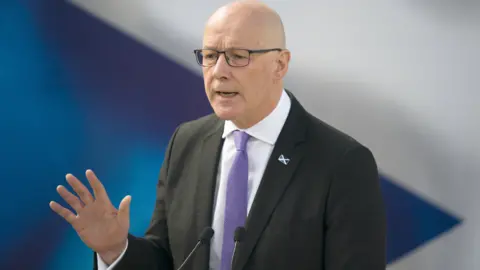Swinney publishes new independence plan and urges referendum if SNP wins majority
First Minister releases latest constitutional paper and calls on Westminster to agree a vote; Prime Minister calls the move 'distraction politics'
First Minister John Swinney on Saturday published the Scottish government's latest paper on the constitution and urged the UK government to agree to a referendum on Scottish independence if the Scottish National Party wins a majority at next year's Holyrood election.
Speaking at a campaign-style event in Edinburgh, Swinney told supporters Scots should "come together and demand a say over our future," presenting the paper as part of a sustained effort to set out the case for independence and the mechanics of a future vote. Prime Minister Sir Keir Starmer dismissed the push, predicting the SNP would not win a majority and accusing Swinney of "distraction politics."

The paper is the latest in a series published by Holyrood Ministers that seek to outline potential arrangements for an independent Scotland. Swinney framed the document as a democratic case for giving people a choice, while noting it would be contingent on the SNP securing an overall majority at the devolved parliament election scheduled for next year.
In his remarks, Swinney also accused some Westminster politicians, including the prime minister, of using what he called "utterly chilling" language about immigrants. He demanded an apology from Sir Keir after the prime minister said Swinney had failed to welcome a recently announced £10 billion shipbuilding deal that Scottish officials say will secure thousands of jobs on the Clyde.
Sir Keir travelled to the BAE Systems shipyard in Glasgow on Saturday, where he defended the government's immigration policies and urged the Scottish government to co-operate on supporting jobs and investment in Scotland. The prime minister reiterated his view that the 2014 independence referendum was a once-in-a-generation decision and said he did not expect the SNP to secure the majority needed to trigger a legally sanctioned vote.
The question of who has the authority to order a referendum has been central to the debate since 2014, when voters rejected independence. Governments in Westminster have repeatedly pointed to that referendum as a restraint on holding another vote, while the SNP argues that a clear majority at Holyrood would provide the democratic mandate to proceed.
Scottish ministers have for years produced papers setting out legal, economic and administrative arrangements they say would underpin an independent Scotland. The latest constitution paper restates arguments on currency, borders and institutions that the party says would be addressed following a successful referendum and during any transition period.
Political analysts say the exchange highlights the wider tensions between Holyrood and Westminster as both governments prepare for a campaign that will shape the tone of next year's election. Swinney’s appeal ties the referendum question directly to the Holyrood vote; Starmer has made clear his government will oppose a second referendum while reiterating his view that it is unlikely the SNP will win the necessary majority.
The Scottish government did not specify a timetable for pursuing formal legal mechanisms to hold a referendum and said any move would be contingent on an electoral mandate. The UK government has maintained that it would only grant permission for a referendum following constitutional and legal processes it deems appropriate.

With the Holyrood election a year away, both sides are preparing a campaign that will combine constitutional arguments with economic and social policy priorities. Swinney’s paper seeks to keep the independence question central to that debate; the prime minister’s public responses underline Westminster’s continued resistance to a second sanctioned referendum.
Officials in both governments said discussions would continue as the election approaches, but provided no immediate sign of movement toward a formal agreement on a vote. The constitutional arguments set out in the paper and the political reactions that followed are likely to shape public discussion in Scotland in the months ahead.